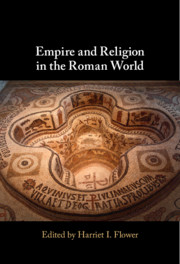Book contents
- Empire and Religion in the Roman World
- Empire and Religion in the Roman World
- Copyright page
- Frontispiece
- Contents
- Figures
- Table
- Contributors
- Acknowledgments
- Introduction
- Part I Empire
- Part II Religion
- Chapter 5 The First Christian Family of Egypt
- Chapter 6 Missionaries, Pious Merchants, Freelance Religious Experts, and the Spread of Christianity
- Chapter 7 Christian Piety in Late Antiquity
- Chapter 8 Ausonius at the Edge of Empire
- Chapter 9 Peregrinationes in Psalmos
- Chapter 10 Muḥammad’s Rivals
- Chapter 11 Brent Shaw
- Appendix: Bibliography of Brent D. Shaw’s Publications to 2020
- Index
- References
Chapter 5 - The First Christian Family of Egypt
from Part II - Religion
Published online by Cambridge University Press: 26 August 2021
- Empire and Religion in the Roman World
- Empire and Religion in the Roman World
- Copyright page
- Frontispiece
- Contents
- Figures
- Table
- Contributors
- Acknowledgments
- Introduction
- Part I Empire
- Part II Religion
- Chapter 5 The First Christian Family of Egypt
- Chapter 6 Missionaries, Pious Merchants, Freelance Religious Experts, and the Spread of Christianity
- Chapter 7 Christian Piety in Late Antiquity
- Chapter 8 Ausonius at the Edge of Empire
- Chapter 9 Peregrinationes in Psalmos
- Chapter 10 Muḥammad’s Rivals
- Chapter 11 Brent Shaw
- Appendix: Bibliography of Brent D. Shaw’s Publications to 2020
- Index
- References
Summary
The chapter discusses a papyrus letter in the Basel papyrus collection that is our earliest autograph of a self-proclaimed Christian. The earliest evidence of Christians in the Egyptian countryside points to a well-traveled and well-read local landed elite. The Basel letter shows that Christians at that time were not hindered from taking public offices in their hometowns. In fact, they were called upon to do so, along with their pagan fellow citizens of means; their financial situation was decisive, not their faith. The Basel letter further illuminates the early spread of Christianity beyond urban centres and the strong links between urban and rural areas operating in a symbiotic relationship. It helps us elucidate the lives of early Christians in the Egyptian countryside during the first half of the third century, a period for which literary evidence is lacking.
- Type
- Chapter
- Information
- Empire and Religion in the Roman World , pp. 117 - 138Publisher: Cambridge University PressPrint publication year: 2021



